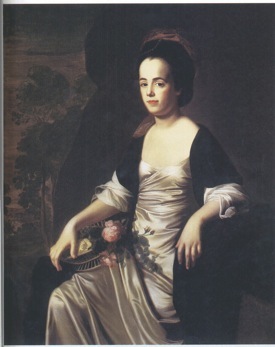Early Life
Judith Sargent Murray was born in Gloucester, Massachusetts on May 5, 1751 to Winthrop Sargent and Judith Saunders. Only three of her siblings survived to adulthood as her four sisters died during childhood. Like most of women of her time, Judith had no formal education. Instead, she educated herself in philosophy, history, geography, and literature by reading in her family’s vast library. At the age of nine years old, Judith also began writing poetry as well as letters. She kept regular correspondence with family and friends. First Marriage
In 1769, when she was eighteen years old, Judith married John Stevens, a ship captain. They had no children but rather adopted two orphans, Anna Plummer and Polly Odell, Stevens’ niece and cousin respectively. In 1770, the Sargent family began following the Universalist faith. They befriended a Universalist preacher named John Murray. They donated land for him to build the first Universalist meetinghouse in the United States. He and Judith became close friends and kept correspondence. At the same time, the American Revolution was taking place. The shipping business dropped rapidly due to unstable seas. By the end of the war in 1783, Stevens was heavily in debt. As a result, Judith began publishing her writings for income. Her first work, “Desultory Thoughts upon the Utility of Encouraging a Degree of Self Complacency, Especially in Female Bosoms” was published in Gentleman and Lady’s Town and Country Magazine under the pen name, Constantia. This essay laid the foundation for Judith’s future works arguing female equality. Around this time, she also began copying down her letters into books for future generations and would continue to do until 1818. Second Marriage
Despite her efforts, Judith’s husband was forced to run away to the West Indies to avoid imprisonment for debt. He died there in 1786. Two years later, Judith remarried the aforementioned John Murray. At age forty, she gave birth to her only child, Julia Maria Murray. Literary Career
Judith continued to publish essays on a wide variety of subjects including federalism, citizenship, and virtue. Expanding on her first work, she also wrote about female equality in “On the Equality of Sexes.” By doing so, Judith became the first person to claim female equality in public print. In addition, “On the Domestic Education of Children” focuses on women’s education and expresses her belief that women were not naturally intellectually inferior. Instead, they were made to be so from the way they were raised. Boys were encouraged to learn while girls were neglected and not allowed to. Judith also wrote that women’s chores did not allow them to fully use their minds. She believed that if they did not find a better use for their intelligence, it would be used for evil. Judith soon began a column in Massachusetts Magazine under the identity of a man named “The Gleaner.” She moved to Boston in 1793. During her stay there, she wrote two plays. After Boston lifted its ban on theatre, “The Medium” was performed at the Federal Street Theatre in 1795. This made Judith the first American author to have her play produced on stage. In the next year, “The Travelled Returned” was produced. Both were mocking examinations of citizenship and virtue in the United States. In 1798, in another attempt to increase income, Judith published a collection of “The Gleaner” columns. She recruited eight hundred presale subscribers and endorsers, which included George Washington and John Adams. As a result, Judith became the first woman to self-publish a book. Later Life
In 1802, Judith helped her cousin, Judith Saunders and Clementine Beach open an school for girls in a town called Dorchester. She placed advertisements and recruited students. The school officially opened in 1803 as the Ladies Academy, teaching both scholarly subjects and domestic skills. Judith’s husband had a stroke in 1809 and eventually died in 1815. After his death, she published his autobiography, Records of the Life of the Rev. John Murray in 1816. Her daughter married a well to do Harvard student named Adam Louis Bingamon. Judith moved with the couple to Natchez, Mississippi and died there on June 9, 1820 at the age of sixty-nine. Her letter books were discovered 164 years later and ten have been published so far. |
Judith Sargent Murray 
|